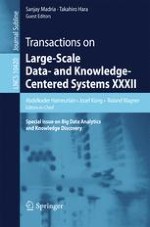The LNCS journal Transactions on Large-Scale Data- and Knowledge-Centered Systems focuses on data management, knowledge discovery, and knowledge processing, which are core and hot topics in computer science. Since the 1990s, the Internet has become the main driving force behind application development in all domains. An increase in the demand for resource sharing across different sites connected through networks has led to an evolution of data- and knowledge-management systems from centralized systems to decentralized systems enabling large-scale distributed applications providing high scalability. Current decentralized systems still focus on data and knowledge as their main resource. Feasibility of these systems relies basically on P2P (peer-to-peer) techniques and the support of agent systems with scaling and decentralized control. Synergy between grids, P2P systems, and agent technologies is the key to data- and knowledge-centered systems in large-scale environments.
This volume, the 32nd issue of Transactions on Large-Scale Data- and Knowledge-Centered Systems, focuses on Big Data Analytics and Knowledge Discovery, and contains extended and revised versions of five papers selected from the 17th International Conference on Big Data Analytics and Knowledge Discovery, DaWaK 2015, held in Valencia, Spain, during September 1-4, 2015. The five papers focus on the exact detection of information leakage, the binary shapelet transform for multiclass time series classification, a discrimination-aware association rule classifier for decision support (DAAR), new word detection and tagging on Chinese Twitter, and on-demand snapshot maintenance in data warehouses using incremental ETL pipelines, respectively.
discovery,="" contains="" extended="" revised="" versions="" five="" papers="" selected="" from="" 17th="" international="" conference="" discovery="" (dawak="" 2015),="" held="" in="" valencia,="" spain,="" during="" september="" 1-4,="" 2015.="" focus="" exact="" detection="" information="" leakage,="" binary="" shapelet="" transform="" for="" multiclass="" time="" series="" classification,="" a="" discrimination-aware="" association="" rule="" classifier="" decision="" support="" (daar),="" new="" word="" tagging="" chinese="" twitter,="" on-demand="" snapshot="" maintenance="" warehouses="" using="" incremental="" etl="" pipelines,="" respectively.
